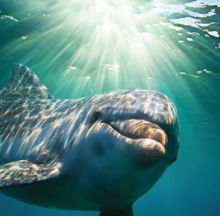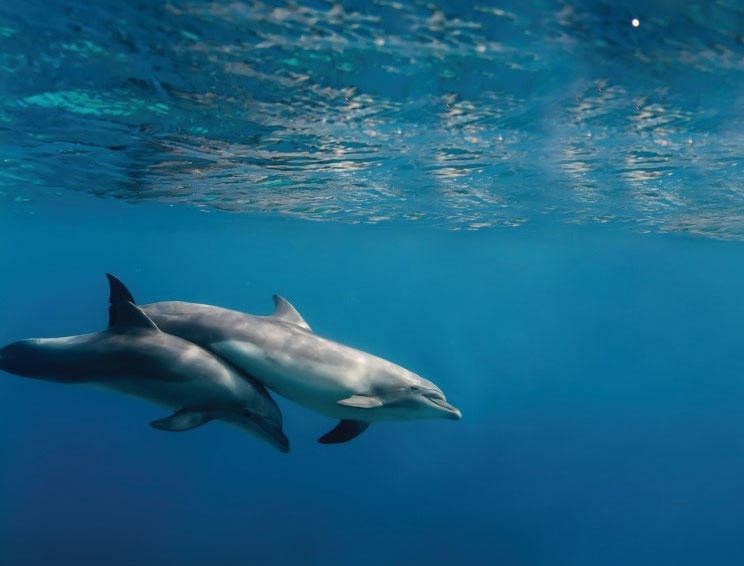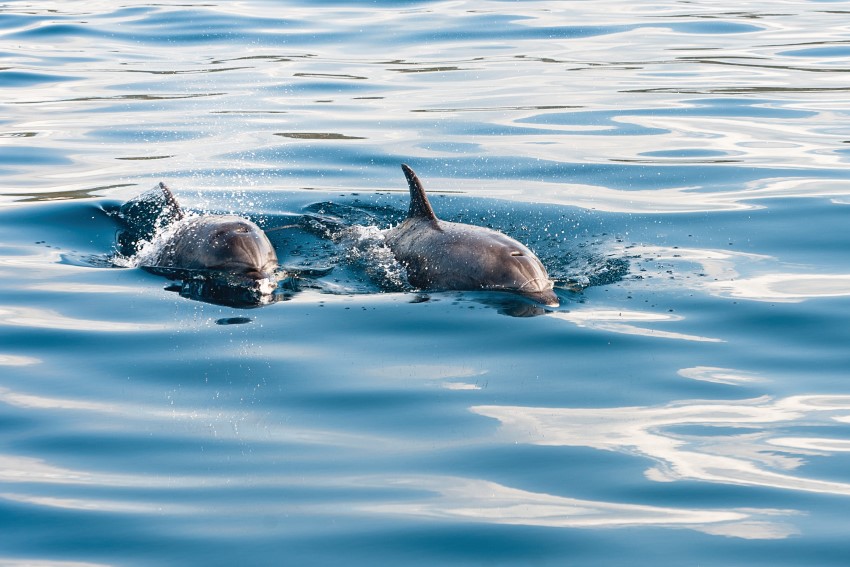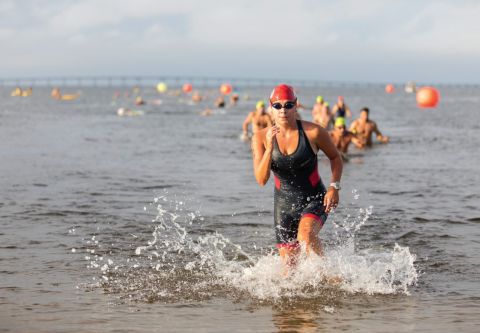
Who else shamelessly interrupts your friends and demands that they look at the ocean the minute you think you see a dorsal fin in the ocean or sound? Like so many people, I grew up loving dolphins. I had no exposure to the actual creatures, which made them all the more intriguing to me. I learned the Flipper theme song and watched dolphin movies enough times to consider myself an expert on the animals. And at the beach, I patiently scanned the ocean’s surface, waiting for a dorsal fin to crest between the waves.
On the Outer Banks, this last activity applies to many of us. Who hasn’t occasionally surveyed the waves from the vantage of the sandy beach, the balcony of a beach house or the deck of a boat, hoping to glimpse the bottlenose dolphins? This population fascinates people of all ages, and we treasure every interaction we have with them. We go boating with knowledgeable captains in hopes of seeing them up close; we take videos of them swimming and surfacing and share them on social media. And we watch and wait and watch until we catch sight of them.
These enchanting creatures captivate us, and I have a few theories why. Pop culture’s given us a pretty romantic image of them. However, we’re likely most drawn to how humanistic they are in nature.
Dolphins’ unrivaled intelligence sets them apart. Next to humans, their brain is the largest of any animal, pound for pound by body size. Their I.Q. is around that of a 5-year-old kid. They learn tricks with ease, and with reasoning more sophisticated than most animals, they also socialize like people. These lively creatures have their cliques (or pods), and they determine their friends, frenemies and foes on a situational basis – another indication of refined behavior and complicated thought processes. They communicate gregariously, using a lexicon of clicks, whistles and burst packets (loud broadband busts of sound). Each sound conveys a different meaning, similar to talking, laughing, crying or shouting.
Have you noticed how people on the Outer Banks fall into two categories? You have the locals and the visitors. The same also applies to the dolphins. Like the majority of people here during the summer, the bulk of the hundreds of dolphins in these waters are visitors passing through, most on migration routes between Beaufort, N.C., and the Chesapeake Bay. Then there’s the smaller population – let’s call them the locals – that prefer to hang out around the Outer Banks consistently when the warmer weather draws them back to northern waters. For the dedicated dolphin watchers, these are familiar faces – or fins, rather – seen repeatedly, week after week and year after year.

Stuart Wescott, owner of Outer Banks Cruises and Captain Johnny’s Dolphin Tours, has more than 20 years of experience getting to know these dolphins. As the original dolphin tour company on the Outer Banks, he holds a unique privilege of watching individuals within the local population mature, raise their young (called calves) that then go on to have their own offspring. He reflects on them in a way reminiscent of an elder who’s watched generations grow up. “We see many of the same dolphins year after year,” he says. “There are some we’ve looked at for 24 consecutive seasons.”
Just like the Outer Banks’ locals, the dolphin locals also have a few of their own resident characters that stand out within the group, with their own names and outspoken personalities. A reputation as one of the longest-spotted dolphins on the Outer Banks makes Onion the most infamous of the bunch, and thanks to his tattered dorsal fin, he's also one of the easiest to recognize. Researchers know the most about him, in part because of his long-time affinity with the Roanoke Sound, and also because his fin makes him just as distinctive to dolphin researchers in Beaufort, who surveyed him over the years during the winter months.
He was first identified by researchers Keith Rittmaster and Nan Bowles in the 1980s, when he swam around the Beaufort waters in winters. They wondered where he disappeared to in the summer, so when the Nags Head Dolphin Watch first sighted him on July 12, 1997, it sparked the initial group of migratory bottlenose dolphins whose travel patterns were tracked throughout the winter and summer. This was a groundbreaking turn in the local research conducted on this species. Through correspondence between the researchers in Beaufort and the Outer Banks, his year-round whereabouts and activities are among the most extensive of any of the dolphins between both locations.
However, it's not just Onion who's stood out over the years. One fin frequently recognized belonged to Artemis, whose deeply curved dorsal fin and, quite often, a calf by her side set her apart. Up until her last sighting in 2016, people watched her young grow and develop their own individual characteristics within the group, almost like how locals watch the neighborhood kids grow into adults. Other recognizable locals included Pinchers – named for the crab-like pincher marks on his fin (died in 2012), Scarlett and Lorna.
Because the local dolphins frequent the sound when they return to the Outer Banks, it doesn’t take many times of spotting their dorsal fins before they become recognizable. For example, Stuart’s able to distinguish them from the visiting dolphins at a glance. When he points out Onion, Scarlett or other big names to his tour goers, tangible excitement follows. Many people have already heard these names, and the moment they spot their dorsal fins is a bit like a celebrity sighting.

This dolphin-inspired excitement is the force that shaped Stuart’s business. Before beginning Captain Johnny’s Dolphin Tours, he debuted his business as nature cruises where he piloted passengers aboard his pontoon boat around the Roanoke Sound, identifying various flora and fauna. People’s widespread delight whenever a dolphin appeared struck him immediately. Stuart made the savvy shift to meet the demand and rebranded his businesses with dolphin tours as the feature. Although he knew nothing about dolphins at the time, 25 years in the business has turned him into an expert on the Outer Banks local bottlenose dolphins.
He’s not a trained scientist, but years of observation give him a wealth of information and fun facts that entertain customers during the dolphin cruises. “In my observation after 25 years, the ocean dolphins pass through, and they’ll stop by the sound to date local girls,” he laughs. When Stuart and the other dolphin tour businesses are out on the water, they communicate amongst themselves about the dolphins’ whereabouts. However, for specifics on the dolphins’ migration patterns and identifying new members, Stuart turns to the local researchers.
On the science end of things, our knowledge about the local bottlenose dolphins comes from the collaborative research and observation done by Nags Head Dolphin Watch, Outer Banks Center for Dolphin Research, Jennette’s Pier and North Carolina Aquarium on Roanoke Island. In 1997, a group of locals, led by Rich and Kate Mallon-Day, formed Nags Head Dolphin Watch to launch a long-term study of these creatures. Up until that time, no formal studies existed for the oft-seen but mysterious marine mammals.
Primarily, Nags Head Dolphin Watch operates as a dolphin tour business. Their eco-tours educate people about the area’s environment, wildlife and conservation and, of course, they usually catch a few dolphin sightings along the way. Since beginning the tours, they photograph the dolphins they spot, collecting opportunistic data and analyzing the population’s trends over the seasons and the years. John Kerner has owned the Dolphin Watch since 2008, and his “built-in expert” for the business, as he likes to describe her, is marine biologist Jessica Taylor.
Jessica started working with the group in 2007 as their on-staff marine biologist, documenting the dolphins and collecting data. Like Stuart’s dolphin-happy passengers, Jessica immediately fell in love with the local dolphins when she came to the Outer Banks. They charmed her with their personalities and the way some individuals’ characteristics distinguished them within the group.
Because a fairly consistent population of dolphins inhabits the sound, they present a unique research opportunity: They give researchers and marine biologists a reliable sample group that can be regularly monitored over the long term. The dolphins passing through the ocean, on the other hand, have harder-to-predict patterns, and the same dolphin may never appear twice. Since the Nags Head Dolphin Watch is a for-profit business, Jessica, Rich and other researchers recognized the opportunity to develop the research around the dolphins in the Roanoke Sound, but they needed additional resources to dive into the science. In 2008 they launched the Outer Banks Center for Dolphin Research (OBCDR) as a 501 (c)(3) nonprofit.

As a nonprofit, the OBCDR has more resources that enable their research and outreach efforts. Their work collaborates with other dolphin studies on the East Coast, with the groups contributing data (photo IDs of dorsal fins and skin lesions) to the Mid-Atlantic Bottlenose Dolphin Catalogue whenever a dolphin is spotted during surveys. The ever-growing and regularly updated catalogue helps marine biologists identify the dolphins, track their movements and follow population trends across different locations. Their work sets the Outer Banks apart as more than a vacation destination – it’s a place that hosts thriving research that shapes our understanding of the Mid-Atlantic’s ecosystems.
The people who regularly see these dolphins get a sense of who’s popular with whom, who isn’t and, in some instances, when something is wrong. One recent example goes back to Onion. He likes pairing with other male dolphins. For years, he frequently was spotted with Pinchers. When Onion suddenly appeared alone, researchers, dolphin tour guides and captains grew concerned. The local researchers conducted frequent and thorough surveys around the waters, and a few days later they found Pincher's body stranded on the beach.
One of the longest-seen dolphins on the Outer Banks was Moe, and he's a choice illustration of how these creatures connect the Outer Banks' research with that conducted in the broader region. Dolphin watchers and researchers spotted Moe swimming in the Roanoke Sound as early as 1997, and they knew him as a longtime visitor to the Outer Banks. In fact, he was the first entry Jessica noted in OBCDR’s dolphin catalogue in 2008. In 2016 researchers in Beaufort discovered Moe's stranded body on the beach. After recovering his remains, his skeleton was rearticulated at the N.C. Maritime Museum and then returned to the Outer Banks. The unveiling of the reconstructed skeleton in February 2019 at Jennette’s Pier in Nags Head was known as Moe’s Homecoming, and the accompanying exhibit explores his life and activities in these waters.
Between the researchers’ findings and the dolphin watch businesses, we get an understanding of how these dolphins behave and interact with each other, especially in distinguishing the locals from the visitors. Dolphins’ sociability often makes them group together, some simply pairing with another individual or joining a pod of many – who knew extroverted and introverted traits apply to dolphins too?
Through their assessment of the Outer Banks’ dolphins, local boaters, tour guides and researchers are able to contribute at a national level to marine biologists’ understanding of the bottlenose dolphins’ travel patterns, population trends and gene pools throughout the East Coast.
When I look at the local cutting-edge research or see the playful pods surfacing and spouting in the waves – like children playing outside – I want everyone to love and marvel at the animals as much as I do. With their complex behavior, antics and likelihood of returning to these waters every year, they’re like our reliable neighbors we expect to see each day or every summer. Unlike our neighbors, though, we can’t get to know the dolphins through passing conversations or an invitation to our next barbecue. But we have stories, and we have science, and they give us narratives of their lives and habits. And when we know them that well, we can’t help but love them even more.
How can you help the Outer Banks dolphins?
Volunteer: Work directly with the dolphins as an OBCDR volunteer! It’s a great opportunity to gain a better understanding of the creatures and make valuable contributions to local research efforts. Volunteers operate research vessels during surveys, identify the dolphins by their dorsal fin markings, help with outreach programs and more. See their website,
obxdolphins.org, or email obxcdr@hotmail.com.
Adopt a dolphin! You won’t bring one of these cool characters home with you (sorry), but you can sponsor a dolphin of your choosing with a $50-minimum donation. To commemorate the adoption, you’ll receive a personalized adoption certificate, fabulous dolphin swag, including an OBCDR t-shirt and bumper sticker, and regular emails with updates on your adopted dolphin.
Save the Date: November 3, 2019, is the 10th Annual Outer Banks Shrimp Cook-Off. Top chefs from across the Outer Banks come to Ocean Boulevard Bistro & Martini Bar in Kitty Hawk to battle for the title of best shrimp preparation. Ticket sales from this event benefit OBCDR’s research.
Ways to protect the dolphins
Clean up after yourself when outside. Even the most innocuous items pose a threat to the dolphins’ well-being. From lost balloons to beach balls and empty soda cans to plastic bags, dolphins suffer potentially life-threatening injuries if they mistake these items for food.
Reduce the amount of chemicals and pesticides you use in daily household goods and lawn maintenance.
Boycott canned tuna or choose “dolphin safe” labels. Large numbers of dolphin bycatches in tuna fishing have resulted in population decreases.
If you encounter a stranded marine mammal between the North Currituck beaches and Nags Head, contact the OBX Marine Mammal Stranding Network at (252) 455-9654. For a stranded animal on the Cape Hatteras National Seashore, call (252) 216-6892.
See the Dolphins!
Nags Head Dolphin Watch
(252) 441-4124
Phoenix Dolphin Cruise – Nags Head
Miss Bodie Island – Manteo
Outer Banks Cruises & Captain Johnny’s Dolphin Tours
(252) 473-1475, Manteo
Harbor Star Dolphin Tours at Wanchese Marina
(252) 423-3157, Wanchese
Paradise Dolphin Cruises
(252) 573-0547, Wanchese
Miss Hatteras & Cap N’ Clam Head Boats
(252) 986-2365, Hatteras


 Hannah Lee is a fiction and creative nonfiction writer living on the Outer Banks. She graduated from Kenyon College in Ohio with a degree in English Literature and Creative Writing. Traveling is her passion, but nowhere ever feels as much like home as the Outer Banks. When not planning her next trip or adventure, Hannah Lee loves aimless drives down the Beach Road, spending copious amounts of time in coffee shops and reading every short story collection she gets her hands on.
Hannah Lee is a fiction and creative nonfiction writer living on the Outer Banks. She graduated from Kenyon College in Ohio with a degree in English Literature and Creative Writing. Traveling is her passion, but nowhere ever feels as much like home as the Outer Banks. When not planning her next trip or adventure, Hannah Lee loves aimless drives down the Beach Road, spending copious amounts of time in coffee shops and reading every short story collection she gets her hands on. 




